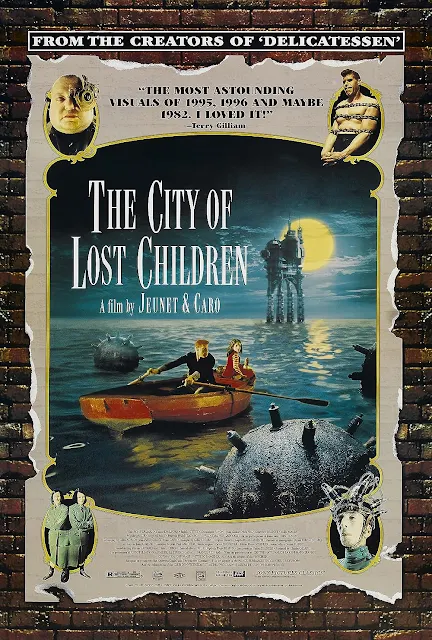Director Jean-Pierre Jeunet's "City of Lost Children" stands as a visual and narrative triumph that continues to captivate audiences with its intricately designed world, thought-provoking themes, and an array of talented actors and production crew members. Released in 1995, this French-German collaboration has left an indelible mark on the science fiction and fantasy genres.
The collaboration between director Jean-Pierre Jeunet (Amelie, Delicatessen) and production designer Marc Caro is the backbone of the film's striking visual aesthetic. Caro's background in illustration is evident in the meticulous attention to detail in every set piece, prop, and costume. The film's dystopian setting, a grimy and industrial world with a touch of steampunk, is brought to life with a masterful combination of practical effects, miniature models, and CGI that seamlessly blend to create a sense of tangible otherworldliness.
The narrative's imaginative and surreal nature is supported by the exceptional writing and the directorial finesse of Jean-Pierre Jeunet. The story revolves around Krank, portrayed with chilling brilliance by Daniel Emilfork, a character both pitiable and malevolent. The intricacies of the plot explore the blurred lines between good and evil, while the film's themes of dreams, innocence, and connection resonate on a deeply human level.
Ron Perlman's portrayal of One, a stoic strongman, showcases the actor's ability to convey complex emotions beneath a rugged exterior. Perlman's physical presence and vulnerability make One a standout character, and his chemistry with Judith Vittet's Miette, a resourceful young girl, forms the emotional core of the narrative. The film's secondary characters, such as the bizarre and lovable diver played by Dominique Pinon, contribute to the film's rich tapestry of personalities.
Beyond the actors, "City of Lost Children" owes much of its success to the talented individuals working behind the scenes. Composer Angelo Badalamenti's haunting and ethereal score elevates the film's atmosphere, immersing viewers further into its fantastical world. Cinematographer Darius Khondji's use of lighting and camera work enhances the film's visuals, while the costumes by Jean-Paul Gaultier bring a unique blend of eccentricity and character to the screen.
At its core, "City of Lost Children" delves into a rich tapestry of themes that resonate deeply with the human experience. One prominent theme is the exploration of the fragility of innocence and the impact of a corrupted world on the purity of childhood. The film's child characters, particularly Miette, stand as symbols of resilience and hope, navigating a grim and treacherous environment while still retaining their innate goodness. The juxtaposition of their innocence against the backdrop of a decaying and morally ambiguous world prompts contemplation about the cost of losing one's innocence and the potential for redemption even in the darkest of circumstances.
Another profound theme lies in the examination of dreams and the power they hold over individuals. Krank's obsession with stealing the dreams of children reflects a desire to reclaim a sense of vitality and imagination that he has lost. This theme explores the complexity of human desires and the lengths people might go to fulfill their aspirations. Through the fantastical premise of dream theft, the film invites viewers to ponder the role dreams play in shaping identity, driving ambition, and serving as a reflection of the human psyche. The exploration of dreams also serves as a metaphor for the film's dreamlike narrative structure, which blurs the lines between reality and imagination, challenging viewers to question the nature of the world presented on screen.
The film's production team's dedication to creating a cohesive and imaginative universe is palpable in every frame. The intricate gadgets, quirky inventions, and fantastical creatures serve as a testament to the creativity of the art department. The practical effects, including elaborate animatronics and miniatures, add a tactile quality that grounds the fantastical elements in a semblance of reality, intensifying the film's impact.
"City of Lost Children" is more than just a film; it's a testament to the power of imagination and collaboration. With its visually arresting design, captivating performances, and a narrative that seamlessly blends fantasy, science fiction, and dark humor, it has solidified its place as a cult classic. Director Jean-Pierre Jeunet's vision, coupled with the remarkable talents of the actors and production crew, has created an enduring masterpiece that continues to bewitch and intrigue audiences, inviting them to explore the depths of its captivating world.
About the author Jimmy Jangles
My name is Jimmy Jangles, the founder of The Astromech. I have always been fascinated by the world of science fiction, especially the Star Wars universe, and I created this website to share my love for it with fellow fans.
At The Astromech, you can expect to find a variety of articles, reviews, and analysis related to science fiction, including books, movies, TV, and games.
From exploring the latest news and theories to discussing the classics, I aim to provide entertaining and informative content for all fans of the genre.
Whether you are a die-hard Star Trek fan or simply curious about the world of science fiction, The Astromech has something for everyone. So, sit back, relax, and join me on this journey through the stars!












